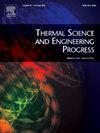影响喷雾冷却换热性能因素的数值模拟研究
IF 5.4
3区 工程技术
Q2 ENERGY & FUELS
引用次数: 0
摘要
随着各种电子器件小型化、高功率、高性能、高集成化的发展,在短时间内可以释放大量的热量。不能及时散热会导致局部过热。喷雾冷却因其优越的冷却效率而受到广泛关注。本文利用数值模拟技术研究了喷雾冷却的传热特性,重点研究了质量流量、喷雾高度、喷雾锥角、添加剂浓度、添加剂类型等因素对传热特性的影响。研究发现:增大工质流量或适当减小喷雾锥角可显著提高喷雾冷却的换热性能。随着喷雾高度的增加,散热器表面温度先降低后升高。当喷雾投影半径约占散热器表面半径的85%时,可获得最佳的喷雾冷却性能。随着甲醇质量分数的增加,喷雾冷却的传热性能逐渐下降。散热器表面热流密度越高,传热性能下降越明显。加入甲醇、乙醇等醇类,或氯化钠、氯化钙等盐类,会削弱喷雾冷却的传热性能。在相同浓度下,盐添加剂的弱化作用更为明显。本文章由计算机程序翻译,如有差异,请以英文原文为准。
Numerical simulation study on factors influencing the heat transfer performance of spray cooling
With the advancement of miniaturization, high power, high performance, and high integration in various electronic devices, significant heat can be released within a short period during operation. Failure to dissipate heat promptly can lead to localized overheating. Spray cooling has garnered considerable attention due to its superior cooling efficiency. This paper utilizes numerical simulation techniques to investigate the heat transfer performance of spray cooling, focusing on the effects of factors such as mass flow rate, spray height, spray cone angle, additive concentration, and additive type on heat transfer characteristics. The study reveals the following findings: Increasing the working fluid flow rate or appropriately reducing the spray cone angle can significantly enhance the heat transfer performance of spray cooling. As the spray height increases, the surface temperature of the heat sink decreases initially and subsequently increases. Optimal spray cooling performance is attained when the spray projection radius constitutes approximately 85% of the heat sink surface radius. An increase in the mass fraction of methanol results in a gradual decline in the heat transfer performance of spray cooling. The higher the heat flux density on the heat sink surface, the more pronounced the decline in heat transfer performance. The addition of alcohols such as methanol and ethanol, or salts such as sodium chloride and calcium chloride, weakens the heat transfer performance of spray cooling. At the same concentration, the weakening effect of salt additives is more pronounced.
求助全文
通过发布文献求助,成功后即可免费获取论文全文。
去求助
来源期刊

Thermal Science and Engineering Progress
Chemical Engineering-Fluid Flow and Transfer Processes
CiteScore
7.20
自引率
10.40%
发文量
327
审稿时长
41 days
期刊介绍:
Thermal Science and Engineering Progress (TSEP) publishes original, high-quality research articles that span activities ranging from fundamental scientific research and discussion of the more controversial thermodynamic theories, to developments in thermal engineering that are in many instances examples of the way scientists and engineers are addressing the challenges facing a growing population – smart cities and global warming – maximising thermodynamic efficiencies and minimising all heat losses. It is intended that these will be of current relevance and interest to industry, academia and other practitioners. It is evident that many specialised journals in thermal and, to some extent, in fluid disciplines tend to focus on topics that can be classified as fundamental in nature, or are ‘applied’ and near-market. Thermal Science and Engineering Progress will bridge the gap between these two areas, allowing authors to make an easy choice, should they or a journal editor feel that their papers are ‘out of scope’ when considering other journals. The range of topics covered by Thermal Science and Engineering Progress addresses the rapid rate of development being made in thermal transfer processes as they affect traditional fields, and important growth in the topical research areas of aerospace, thermal biological and medical systems, electronics and nano-technologies, renewable energy systems, food production (including agriculture), and the need to minimise man-made thermal impacts on climate change. Review articles on appropriate topics for TSEP are encouraged, although until TSEP is fully established, these will be limited in number. Before submitting such articles, please contact one of the Editors, or a member of the Editorial Advisory Board with an outline of your proposal and your expertise in the area of your review.
 求助内容:
求助内容: 应助结果提醒方式:
应助结果提醒方式:


